If you are new here, don’t forget to check our Discord Channel. it’s free for everyone!
If you are looking for more Scam content, including the sideboard guide, click here.
A typical decklist:
If you can’t see the link or want a downloadable version, click here.
Basics
What is Scam?
Rakdos Evoke, or “Scam”, is a combo-style aggro deck which focuses on heavy disruption combined with a fast clock that ends games quickly without giving your opponent a chance to assemble their gameplan. It utilises various spells which essentially reanimate evoked Elementals in Fury and Grief on turn one to gain an oppressing advantage on the board. Typically on turns one and two you are leading with a threat that must be answered immediately or can run away with the game in a short period of time. Your individual card quality is very high, meaning you don’t necessarily require the “combo” to win games as your midrange plan is often good enough to get there.
Why is it good? What is the best metagame for this deck?
In my opinion, the true strength of the deck lies in the fact that your range of powerful gameplans is varied- you can of course simply produce a Grief or Fury on turn one, however a simple Ragavan into Thoughtseize or Orcish Bowmasters into Fable of the Mirror Breaker are often decent enough curves to create a dominant presence on the board. I think the best metagame for this deck would be one full of low or medium-statted creature strategies or fragile combo decks that suffer from heavy discard.
What are the deck’s biggest weaknesses?
Decks that run a lot of exile-based removal can be problematic since you don’t have any efficient answers to a card such as Leyline Binding or Solitude in red and black. Combo decks that run maindeck removal such as Temur Rhinos can present a board state that eclipses your creatures and quickly pressures your life total. Finally, hard control decks running cards such as Teferi, Time Raveler, Subtlety and Supreme Verdict along with the aforementioned exile-based removal can also efficiently trade with your gameplan.
Maindeck – analysis card by card
The namesakes
Grief
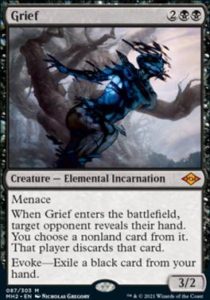
The signpost card of the deck. It functions as a combination of disruption and pressure when used with your various undying spells to take the two best cards from your opponents deck while leaving a 4/3 body with evasion that can end the game in just a few turns. Against super removal-heavy decks you might want to consider hardcasting this spell to accrue card advantage since they have to remove it and you still get a card from their hand. It interacts nicely with some of your other cards such as a Reflection of Kiki-Jiki copying it in their draw step to “lock” them out of playing the game. You can also cast Lightning Bolt and an undying spell killing your own Grief to disrupt them during their draw step. Much of this card’s true skill however lies in discerning which cards to discard from their hand. More on this later.
Fury
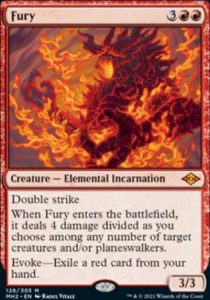
The second signpost card of the deck, Grief’s red and angry partner in crime. Where Grief interacts with the opponent’s hand, Fury interacts with their board, dealing up to eight potential damage spread over as many targets as you choose before remaining on the board as a 4/4 or 3/3 double striker. If it’s a 4/4, or if your opponent has fetched, it will kill them before their third turn. You can also just Evoke it to remove blockers to allow your Ragavan to connect or stack the triggers such that you remove a Teferi, Time Raveler and then follow up with your undying spell to bring it back. The four damage is also very relevant against a particularly problematic creature, Omnath, Locus of Creation, which is a card you may often find yourself losing to.
Undying spells: Not Dead After All, Undying Evil, Feign Death, Malakir Rebirth
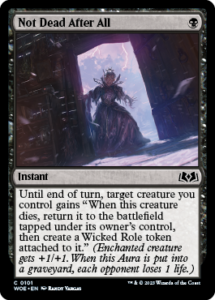
The second half of the Scam combo, these undying spells allow you to gain a dominating board presence from turn one or simply counter certain removal spells by having the creature return to the battlefield. Not Dead After All is the best one of the bunch, since the life loss can be relevant, and the scenarios where the token is exiled and not sent to the graveyard are very scarce. Undying Evil is the second best effect since your creature returns to the battlefield untapped which is crucial against opposing Ragavans. Of course the downside is you cannot give a creature of yours with any +1/+1 counters Undying a second time. Since it is usually a two-of this is a rare case but it could come up and I could see playing a 1/1 Split with Undying Malice. The downside is no longer as relevant now that Not Dead After All only gives a +1/+1 static ability, not a counter.
Other threats
Ragavan, Nimble Pilferer
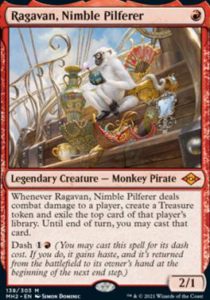
Ragavan, Nimble Pilferer is among the most powerful one drops in all of Magic. It functions as a win condition on its own, generating mana advantage and card advantage each time it deals damage to your opponent. Simply put, you can have three mana on turn two and have almost drawn an extra card while dealing two damage to your opponent. It sounds busted because it is. In the context of Scam Ragavan simply functions as another turn one oppressive threat that must be answered immediately. It allows you to cast your Fable of the Mirror Breaker on turn two, can be pitched to Fury and also dashed later in the game to start drawing cards from your opponents deck. Redundant Ragavans can be discarded to Fables later on. Playing less than four copies maindeck is unforgivable as it is one of your strongest turn one plays, especially when going first. You can use the dash ability to avoid sorcery speed removal such as Prismatic Ending or Fury or Wrenn and Six. There is however a somewhat new answer to Ragavan that’s terribly effective and works even against a dashed Monkey…
Orcish Bowmasters

The newest addition to the deck, Orcish Bowmasters allows us to play more at instant speed whilst acting as pseudo removal and a way to hose decks that draw excessive cards. For example, Up the Beanstalk gets punished by your Bowmasters dealing damage to them and quickly growing your Orc Army token. This card is not as inherently powerful as other cards in the deck but in multiples and against the right opposing deck it is indeed a menace that must be answered sooner rather than later. Generally if your opponent is at a high enough life total you shouldn’t let Up the Beanstalk resolve before casting your Bowmasters. This is because giving them the option to draw a card from the Beanstalk trigger is often more beneficial than detrimental to them. However if they are around 6-7 life or lower you should consider waiting until the Beanstalk resolves as this way they will take more damage if they choose to evoke an Elemental such as Solitude. Try not to get your Bowmaster killed for free by theirs, especially if you are holding an Undying effect it may prove wise to wait the extra turn to have the extra mana to facilitate this. You can always target your own Army token if your opponent has protection from their One Ring, and since the ability is simultaneous your token won’t die during this process (provided there is no damage already on it).
Dauthi Voidwalker
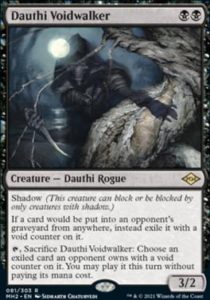
A frequent feature in some Legacy decks, Dauthi Voidwalker is a fundamentally overpowered card that achieves many effects for the low price of two mana. Aggressively, a two mana 3/2 with essentially unblockable is a great way to start pressuring your opponent’s life total. Its passive ability effectively acts as a better Leyline of the Void effect on a creature which can completely derail some decks in game one where they require the use of the graveyard. Obvious scenarios include Yawgmoth’s Undying creatures, Living End’s cyclers, enabling Delirium, opposing Undying effects in the mirror and random decks such as Dredge. The activated ability however is truly a unique effect on such a cheap card. You can combine this ability with Thoughtseize or Grief to essentially “steal” your opponents payoffs such as The One Ring, Karn the Great Creator or Fury. You can also cast your Undying spell on the Voidwalkler before sacrificing it to just get it back and repeat the process whenever you draw a discard spell. It also helps vastly improve your chances against Crashing Footfalls as it represents a set of 4/4 Rhinos provided it was not removed (which, granted, is unlikely to happen). Note this card functions unfavourably with Leyline of the Void since your opponent gets to choose which effect takes precedence. Also, if your Voidwalker gets blocked by another one they both get exiled to each other with a counter. It also synergizes somewhat with a Reflection of Kiki-Jiki, as you can copy the summoning sick Voidwalker and then sacrifice the copy to cast a spell exiled with a void counter on the same turn.
Fable of the Mirror-Breaker
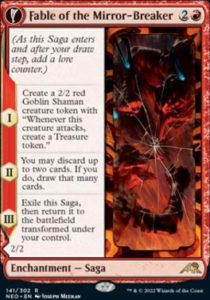
I have considered myself somewhat of a “Fable-Maxi”, which means I think that the card is underplayed and highly powerful in basically all formats. The card, if it resolves, provides you with a clean 3 for 1 which is a nightmare for many decks to deal with. The first part creates a 2/2 Goblin Shaman that can block efficiently, start beating down your opponent and most importantly generates Treasures to develop a mana advantage. This is extremely relevant for the second chapter which allows you to dig deeper into your deck by discarding up to two cards and drawing two fresh ones. You see, if your Goblin token is creating Treasures, you can turn those lands in your hand into powerful spells for free! Finally, the third chapter becomes basically a nerfed version of Kiki-Jiki, Mirror Breaker. The reverse side of Fable is an effective win condition when combined with your other cards such as Grief, Fury or Dauthi Voidwalker. Counterspells are essentially the only way to trade even with Fable. Be careful when thinking what to discard since if your opponent has an Orcish Bowmasters in play you or your token will be taking damage. You can also give the back side Undying to get back your Fable with a +1/+1 counter and begin the value cycle all over again. If you have at least two copies of the back side, in your end step you should make a copy of the backside and then in their end step make copies of the copy which means they can choose whether to take more damage and kill the original or take less damage but be forced to kill the copy.
Blood Moon
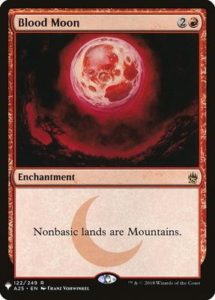
Blood Moon has become less and less useful in Modern as decks are equipped with better answers such as Boseiju, who Endures and Leyline Binding. However, it still is a serious threat for certain land based strategies. If you are playing an open decklist event or a local event where you know the meta will contain multiple Tron, Amulet Titan or Urza’s Saga decks then it might be prudent to include some copies of Blood Moon in your main deck. In a meta heavy of mirrors or closed decklists however I would argue its uselessness can be pretty acute if you topdeck the card when you really needed to find some gas. Ensure to fetch at least two Basic Swamps if possible, since you can draw Dauthi Voidwalker. Always remember that a Blood Moon without pressure can be very very underwhelming so try to combine it with any cheap creature that keeps your opponent’s life total in check.
Interactive spells
Thoughtseize
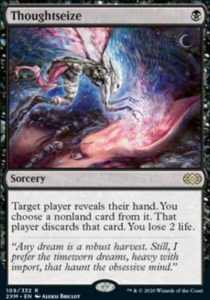
This can be thought of as a less efficient Grief that interacts with your opponent’s hand and most importantly gives you information about their likely play patterns and gameplan in that match. This is one of the hardest cards in Magic to use effectively and hundreds of pages could be written on how to use it. However, in general you’ll want to be taking the most efficient answers to your most dangerous threats. I feel like this is a good way of describing its usage, other than other scenarios where you don’t have much choice or you’re using it with Dauthi Voidwalker. An advanced use of the card which most players don’t think properly consider is knowing *when* to cast it. Whilst casting it on turn one is often an efficient use of your mana curve, if your opponent has specific threats that cost for example 4 or 5 mana you may want to consider holding the thoughtseize until turn 3-4 where you then gain the most information in a crucial turn.
Terminate
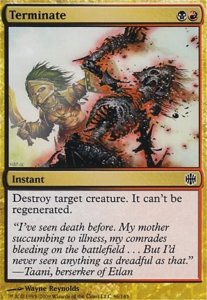
There isn’t much to say about this card, it’s a multicolour card which pitches to both Evoke Elementals that cleanly answers any creature such as Murktide Regent or Yawgmoth, Thran Physician. It bypasses Welding Jar along with other various regenerate creatures. One of its best usages is responding to an Omnath, Locus of Creation draw trigger which prevents your opponent from being able to play a land and therefore denying them important life gain, which this deck can seriously struggle against. Consider Terminating opposing Grief/Furies while your opponent has no mana available to prevent any Undying shenanigans.
Lightning Bolt
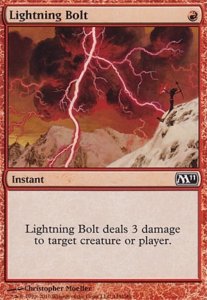
The classic red deal three spell functions as efficient removal for most of the format, as well as some reach in terms of closing the game. You can Bolt your own Grief if you have an Undying spell in their draw step to deal with sorcery speed threats or removal such as The One Ring or Supreme Verdict. You can also deny your opponent’s lifegain by casting Bolt on the target or creature they are attempting to gain life from using Solitude.
Fatal Push
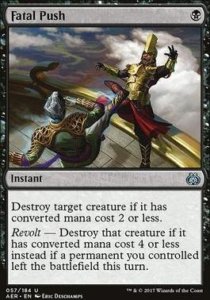
I’m personally a big fan of this card in the current meta but I think the reach from Lightning Bolt is more relevant in an open meta, at least maindeck-wise. I am definitely not adverse to running some copies in the main at some point however.
The manabase
The manabase of this deck is not too complicated. You have all four Blood Crypts, some fetchlands and Blackcleave Cliffs. Most people run 3 Cliffs however I think I’m happy with the fourth copy. The curve of the deck is low and it’s relatively rare that Cliffs’s drawback comes up. I like saving the life you’d usually have to spend from fetching. If you play Tourach, you should probably have 3 Swamps, but if you don’t I don’t really see the point. Some other options include:
- Mount Doom: I don’t have much against this land but I think if you keep a one lander as you do then the self damage is far from ideal
- Takenuma, Abandoned Mire: I think this is a good card and pretty free to play but it is very slow and not good against Leyline of the Void
- Agadeem’s Awakening: big fan of this one, a pitchable land and your life total doesn’t come up very often. I have also cast the front side more than a few times
Sideboard options
Leyline of the Void
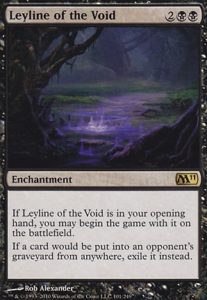
I think this might be the main difference between my decks and most others lists. It is definitely great against Living End and UR Murktide, however Living End isn’t very popular and UR Murktide is branching into Questing Druid which doesn’t require using graveyard. In the mirror and against Yawgmoth I think it is just okay. It’s effective against Agatha’s Soul Cauldron, but you do also have Dauthi Voidwalker to tackle it. In the mirror it does prevent their Scam openers but does nothing against Ragavan or Fable of the Mirror-Breaker. I understand you can pitch it or discard it but I feel in general the card is only good against really fast graveyard strategies such as Dredge or Hogaak, which don’t particularly exist in the format currently.
Blood Moon//Magus of the Moon
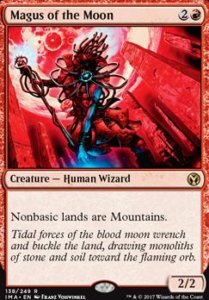
I already mentioned times where this is strong in the earlier section but it is an effective tool to punish any greedy domain manabase or mana ramp strategies such as 4c, Tron or Amulet Titan. The main thing to note about Blood Moon is its effectiveness depends massively, at least in my opinion, on whether you are going first or second. A Blood Moon played on turn three on the play is very scary for many decks whereas the same card played on the draw is often laughable. There are a few reasons why you’d play some kind of split of these effects. Firstly, it makes it harder for your opponents to deal with them, as typically enchantments and creatures require different answers. Secondly, the 2/2 body on Magus can be a relevant attacker/blocker in certain matchups where speed is everything such as Tron or Amulet. The general rule is if your opponent’s deck contains cards such as Fatal Push or Lightning Bolt then Magus is not an effective way to attack their manabase and Blood Moon is. Conversely, if your opponent is running many copies of Boseiju, who Endures and not much creature removal then Blood Moon looks much more appealing. Splits are best versus decks such as Amulet and Tron where we need to overwhelm them with diverse threats.
Sheoldred, the Apocalypse
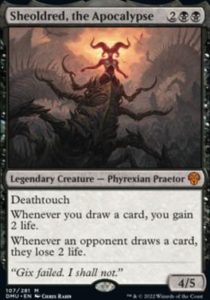
I have to say that I love this card and it is incredibly based. Sheoldred has innumerable upsides – it functions similarly to Ragavan in the way that it wins the game simply on its own, without even attacking, provided you don’t miss your triggers. It is a curve topper in a postboard “grindfest” where you are playing more of a midrange deck that accepts its explosive starts can’t always win on their own. Notably, this card cannot be answered by Lightning Bolt or Fury. It also penetrates the Ring’s protection clause. In mirrors, always ensure you have an answer to your opponents Sheoldred if you can.
Seasoned Pyromancer
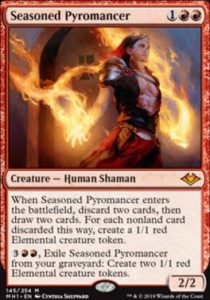
This card is just an all-star for Scam. Previous versions played Pyromancer over Fable of the Mirror breaker for quite a while. I do believe Fable is overall a better card in the deck right now, and that is saying a whole lot! Pyromancer synergises with the deck in so many ways – You often sacrifice cards by Evoking your Elementals, so it lets you refuel. It synergizes excellently with your Undying spells. It makes annoying blockers for Ragavan and attackers to kill planeswalkers. I think the card would see more play in the maindeck if it weren’t for the card Orcish Bowmasters. The fact that your opponent can guarantee to kill your Pyromancer while making a 2/2 for “free” is the only thing that prevents Pyromancer being one of the best cards for the deck. It gives more velocity than Fable which is relevant in matchups such as Tron where you just need to kill them as quickly as possible.
Tourach, Dread Cantor
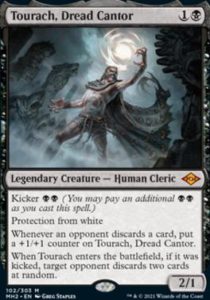
Having previously been a fan, I no longer appreciate this card due to the uptick in cards like Fury, Lightning Bolt and Fire/Ice. It just dies to too many red cards at the moment for it to be effective, although I could see running 1 copy for some threat diversity.
Kolaghan’s Command
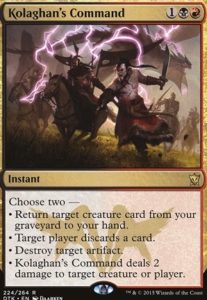
A reasonable value card for mirrors and against Agatha’s Soul Cauldron decks that pitches to both Evoke Elementals. I have nothing in particular against it and think it’s one of the viable options to play to deal with Ensnaring Bridges and rogue artifacts.
Hidetsugu Consumes All
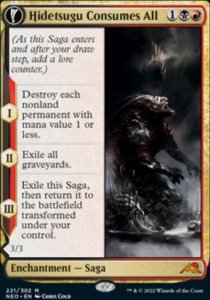
While admittedly narrow it’s application, Hidetsugu Consumes All can be a total blowout against many decks such as Hammer, Hardened Scales and to some extent Temur Rhinos. With Pithing Needles to name Engineered Explosives, this Saga looks more and more attractive. It also synergises very nicely with your undying spells to repeat the first chapter and send your opponent back to the Stone Age once again.
Engineered Explosives
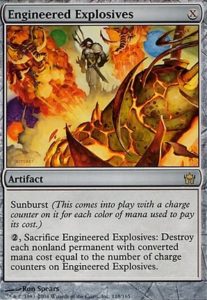
Less needed now than before, as mentioned above Hidetsugu does a similar job but with a better effect. Explosives remains the best answer to Sanctifier en-Vec, but other than that I don’t see a huge incentive to play it over other cards right now. One copy might be the right number in the board.
Chalice of the Void
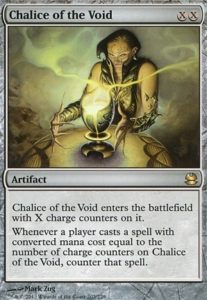
As my friend Alex explained to me, Chalice is great in a deck like Scam because you need effects for the minimum amount of resources invested, and being a zero mana continuous counterspell for cascade strategies, Chalice is an efficient and quick card that’s worth sideboard slots.
Unlicensed Hearse
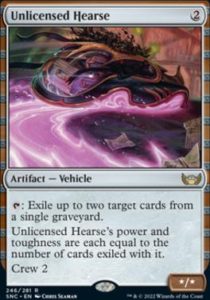
I know some people have played this but it seems pretty slow and underpowered to me. I don’t think the effect it provides – a grindy piece of graveyard hate – is what the deck needs at all.
Alpine Moon
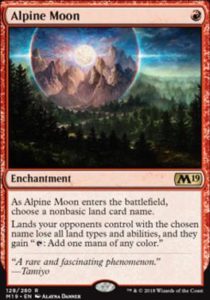
There are a bunch of decks that play Urza’s Saga such as Hammertime or Jund Saga which Blood Moon is often overkill for. Therefore I kind of like the idea of a cheap card to counteract much of their gameplan, especially since Urza’s Saga is often a really great card against Scam that can’t be answered too effectively between your discard and sorcery speed removal.
Duress
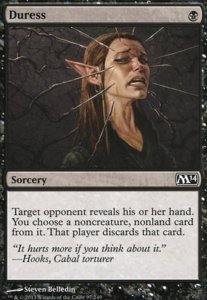
I think this final sideboard slot is up for debate and I could see a third copy of Sheoldred, the Apocalypse or Engineered Explosives as well. I think I like Duress since discard can pave the way for your easy quick wins combined with the pressure you can put on the board. Cards such as Ragavan pair excellently with discard spells since they effectively win the game on their own if left unanswered. Think of Duress as a fifth copy of Thoughtseize and you’ll see what I mean. It doesn’t answer cards such as Solitude or enemy Ragavans though, so you’ll want to be careful when you board it in. It also can be relevant if going first or second such as against Amulet Titan where if you go first you gain the ability to discard their Amulet of Vigor and if on the draw I likely wouldn’t bring it in.
Gameplay
Mulliganing
As a general rule you should look to find a turn one Elemental if possible in game one. I’d never advocate hard mulliganing for one but I would give preference to those hands if possible. This is because in game one your opponent has less specialised tools to deal with such an oppressive start compared to sideboarded games. I would always go for turn one Fury in the blind. My soft rule for mulliganing with the deck is that my opening hand should have either an Elemental or Ragavan on turn one. Without these, there is a chance your gameplan will be too slow and not direct enough. Once you know the matchup however you can mulligan more flexibly for the appropriate cards for that deck.
Mulliganing – examples
#1
#2
#3
#4
#5
#6
#7
#8
Sequencing
When given the choice between making a turn one Grief or playing a Ragavan, I would almost always choose the Elemental, as Ragavan is great as a dashed turn two play anyway. Make sure you lead with a land and resolve the triggers in such a way that the Evoke resolves after the first discard effect. If the opponent has a castable removal spell in hand, you’ll probably need to take this first before you commit to the Undying spell to prevent them responding to the target by removing, and thus killing, your Grief.
Tips and tricks
- Don’t forget you can cast an Undying spell on your own creature before removing it yourself to gain a desired ETB effect, often at instant speed. This is relevant with Grief in the opponent’s draw step and Fury removing their creatures again.
- If you use an Undying spell on your Dauthi Voidwalker before sacrificing it, if the spell you would cast for free from exile would be put into the opponent’s graveyard, you can recast it again next turn since your Voidwalker will return to the battlefield upon resolution. This is particularly relevant against Crashing Footfalls.
- You can Evoke an enemy elemental if it gets exiled by Ragavan, provided you pitch an appropriately coloured card from your hand.
- Remember that Hidetsugu Consumes All destroys your Ragavans, Treasures and Role tokens.
- You can use Role tokens to deal damage to your opponent through Ring protection.
- If you suspect an opponent has a hasted/dashed creature you may want to use Undying Evil instead of Not Dead After All as it will come back untapped.
- The reason you would cast Bowmasters in response to the Beanstalk cast and not trigger is that you give your opponent the chance to not draw a card (usually beneficial for them) by Solituding before the Beanstalk resolves. The case when you would do the opposite is when they are on low life and you would force them to take an extra point of damage from the Beanstalk trigger.
